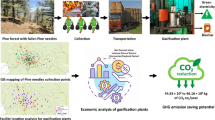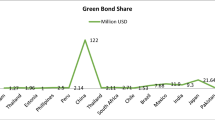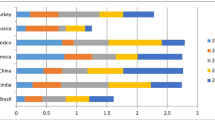Abstract
In this paper, bank financing (BF) and trade credit financing (TCF) are viable. We investigate the financing choice problem for an emission-dependent manufacturer with capital constraints. Each supply chain member pursues its profit maximization. In the literature on the financing supply chain, enterprises and consumers become increasingly aware of environmental protection. A growing number of manufacturers produce low-carbon products, such as environmentally friendly bags, through a green supply chain system. We use the Stackelberg game to study the equilibrium financing choice and optimal decisions. We also perform numerical analysis to verify the impact of certain parameters on financing decisions. The results show no direct relationship between the degree of carbon reduction and the total amount of carbon emissions as defined by the government. In addition, when the trade credit interest rate is higher than the bank interest rate, the manufacturer chooses bank financing. When the credit interest rate is lower than a certain threshold, the retailer provides trade credit financing. Our study also provides useful insights for managers to understand and make financing decisions in a low-carbon supply chain with a capital-constrained manufacturer.









Similar content being viewed by others
Data availability
All data generated or analyzed during this study are included in this published article.
References
Benjaafar S, Li Y, Daskin M (2013) Carbon footprint and the management of supply chains: insights from simple models. IEEE Trans Autom Sci Eng 10(1):99–116
Berger AN, Udell GF (2006) A more complete conceptual framework for SME finance[J]. J Bank Financ 30(11):2945–2966
Bhattacharya A, Dey PK, Ho W (2015) Green manufacturing supply chain design and operations decision support. Int J Prod Res 53(21):6339–6343
Cao E, Lingxia Du, Ruan J (2019) Financing preferences and performance for an emission-dependent supply chain: supplier vs. bank. Int J Prod Econ 208:383–399
Chen X (2015) A model of trade credit in a capital-constrained distribution channel. Int J Prod Econ 159:347–357
Chen X, Cai G, Song JS (2019a) The cash flow advantages of 3PLs as supply chain orchestrators. Manuf Serv Oper Manag 21(2):435–451
Chen X, Wang X, Zhou M (2019b) Firms’ green R&D cooperation behaviour in a supply chain: technological spillover, power and coordination. Int J Prod Econ 218:118–134
Chen D, Tian C, Chen Z, Zhang D (2020) Competition among supply chains: the choice of financing strategy. Oper Res Int Journal 22(2):977–1000
Chen X, Cai G (George) (2011) Joint logistics and financial services by a 3PL firm. Eur J Oper Res 214(3):579–587
Cong J, Pang T, Peng H (2020) Optimal strategies for capital constrained low-carbon supply chains under yield uncertainty. J Clean Prod 256:120–359
Ding W, Wan G (2020) Financing and coordinating the supply chain with a capital-constrained supplier under yield uncertainty. Int J Prod Econ 230:107813
Ding W, Jin W (2023) Production operations, financing and information asymmetry in a supply chain with a random yield[J]. Appl Econ 18:1–21
Du S, Zhu L, Liang L, Ma F (2013) Emission-dependent supply chain and environment-policy-making in the ‘cap-and-trade’system. Energy Policy 57:61–67
Du S, Zhu J, Jiao H, Ye W (2015) Game-theoretical analysis for supply chain with consumer preference to low carbon. Int J Prod Res 53(12):3753–3768
Fang L, Xu S (2020) Financing equilibrium in a green supply chain with capital constraint. Comput Ind Eng 143:106390
Feng Z, Luo N, Shalpegin T, Cui H (2023) The influence of carbon emission reduction instruments on blockchain technology adoption in recycling batteries of the new energy vehicles[J]. Int J Prod Res 36:1–18
Hafezalkotob A (2018) Modelling intervention policies of government in price-energy saving competition of green supply chains. Comput Ind Eng 119:247–261
Huang S, Fan ZP, Wang X (2019) Optimal operational strategies of supply chain under financing service by a 3PL firm. Int J Prod Res 57(11):3405–3420
Huang J, Yang W, Tu Y (2020) Financing mode decision in a supply chain with financial constraint. Int J Prod Econ 220:107441
Huang S, Fan ZP, Wang X (2021) Optimal financing and operational decisions of capital-constrained manufacturer under green credit and subsidy. J Ind Manag Optim 17(1):261
Jing B, Chen X, Cai G (2012) Equilibrium financing in a distribution channel with capital constraint[J]. Prod Oper Manag 21(6):1090–1101.
Kanada M, Fujita T, Fujii M, Ohnishi S (2013) The long-term impacts of air pollution control policy: historical links between municipal actions and industrial energy efficiency in Kawasaki City, Japan. J Clean Prod 58:92–101
Kang K, Gao S, Gao T, Zhang J (2021) Pricing and financing strategies for a green supply chain with a risk-averse supplier. IEEE Access 9:9250–9261. https://doi.org/10.1109/ACCESS.2021.3050130
Kassinis GI, Soteriou AC (2003) Greening the service profit chain: the impact of environmental management practices. Prod Oper Manag 12(3):386–403
Klassen RD, McLaughlin CP (1996) The impact of environmental management on firm performance. Manage Sci 42(8):1199–1214
Kouvelis P, Zhao W (2016) Supply chain contract design under financial constraints and bankruptcy costs. Manage Sci 62(8):2341–2357
Lai, Z., Lou, G., Yin, L. et al (2023) Supply chain green strategy considering manufacturers’ financial constraints: how to manage the risk of green supply chain financing. Ann Oper Res. https://doi.org/10.1007/s10479-023-05239-z
Lee S, Park SJ (2020) Who should lead carbon emissions reductions? Upstream vs. downstream firms. Int J Prod Econ 230:107790
Li Z, Yang W, Pan Y (2021) Carbon emission reduction cooperation in supply chain with government subsidies. IOP Conf Ser: Earth Environ Sci 647(1):12129 (IOP Publishing)
Liu ML, Li ZH, Anwar S, Zhang Y (2021) Supply chain carbon emission reductions and coordination when consumers have a strong preference for low-carbon products. Environ Sci Pollut Res 28(16):19969–19983
Luo Y, Wei Q, Ling Q, Huo B (2020) Optimal decision in a green supply chain: bank financing or supplier financing. J Clean Prod 271:122090
Pathak U, Kant R, Shankar R (2020) Analytics of cap-and-trade policy for dual supply chain network structures. Clean Technol Environ Policy 22(10):1999–2021
Qin JJ, Ren LG, Xia LJ, Wang ZP, Chang HD (2020) Pricing strategies for dual‐channel supply chains under a trade credit policy. Int Trans Oper Res 27(5):2469–2508
Ren Q, Ku Y, Wang Y, Wu P (2023) Research on design and optimization of green warehouse system based on case analysis. J Clean Prod 409: 135998
Sun L, Cao X, Alharthi M, Zhang J, Taghizadeh-Hesary F, Mohsin M (2020) Carbon emission transfer strategies in supply chain with lag time of emission reduction technologies and low-carbon preference of consumers. J Clean Prod 264:121664
Taleizadeh AA, Shahriari M, Sana SS (2021) Pricing and coordination strategies in a dual channel supply chain with green production under cap and trade regulation. Sustainability 13(21):12232
Waltho C, Elhedhli S, Gzara F (2019) Green supply chain network design: a review focused on policy adoption and emission quantification. Int J Prod Econ 208:305–318
Wang Z, Wu Q (2021) Carbon emission reduction and product collection decisions in the closed-loop supply chain with cap-and-trade regulation. Int J Prod Res 59(14):4359–4383
Wang Q, Zhao D, He L (2016) Contracting emission reduction for supply chains considering market low-carbon preference. J Clean Prod 120:72–84
Wu DD, Yang L, Olson DL (2019) Green supply chain management under capital constraint. Int J Prod Econ 215:3–10
Wu Y, Lu R, Yang J, Wang R, Xu H, Jiang C, Xu F (2021) Government-led low carbon incentive model of the online shopping supply chain considering the O2O model. J Clean Prod 279:123271
Xu L, Luo Y, Shi J, Liu L (2022) Credit financing and channel encroachment: analysis of distribution choice in a dual-channel supply chain. Oper Res 22(4):3925–3944
Yan N, Sun B, Zhang H, Liu C (2016) A partial credit guarantee contract in a capital-constrained supply chain: financing equilibrium and coordinating strategy. Int J Prod Econ 173:122–133
Yang H, Zhuo W, Shao L (2017a) Equilibrium evolution in a two-echelon supply chain with financially constrained retailers: the impact of equity financing. Int J Prod Econ 185:139–149
Yang L, Zhang Q, Ji J (2017b) Pricing and carbon emission reduction decisions in supply chains with vertical and horizontal cooperation. Int J Prod Econ 191:286–297
Yang H, Miao L, Zhao C (2019) The credit strategy of a green supply chain based on capital constraints. J Clean Prod 224:930–939
Zarei MH, Carrasco-Gallego R, Ronchi S (2019) To greener pastures an action research study on the environmental sustainability of humanitarian supply chains[J]. Int J Oper Prod Manag 39(11):1193–1225
Zhang B, Ye Y, Yue X (2019) Evolutionary strategies of supply chain finance from the perspective of a return policy. IEEE Access 7:110761–110769
Zhang Q, Yang D, Qin J (2023) Multi-party evolutionary game analysis of accounts receivable financing under the application of central bank digital currency. J Theor Appl Electron Commer Res 18(1):394–415
Zhou X, Wu X (2023) Decisions for a retailer-led low-carbon supply chain considering altruistic preference under carbon quota policy. Mathematics 11(4):911
Funding
The research is provided by Fundamental Research Funds for the Central Universities (Grant No. 22LZUJBKYDX004), Young Doctoral Foundation of Gansu Province (Grant No. 2022QB-010), and Soft Science Special Project of GanSu Basic Research Plan (Grant No. 22JR4ZA043) and Study and Interpret the Spirit of the Party's 20th National Congress Project of Lanzhou University (Grant No. 2023LZDXJBKYZX009).
Author information
Authors and Affiliations
Corresponding author
Ethics declarations
Ethical approval
Not applicable.
Consent to participate
Not applicable.
Consent for publication
Not applicable.
Competing interests
The authors declare no competing interests.
Additional information
Responsible Editor: Nicholas Apergis
Publisher's note
Springer Nature remains neutral with regard to jurisdictional claims in published maps and institutional affiliations.
Appendices
Appendix 1
Proof of Lemma 1
Let us find the first derivative of Eqs. (12) and (13) with respect to \(\theta\), and the following results can be obtained.
Proof of Lemma 2
Let us find the first derivative of Eqs. (19) and (20) with respect to \(\theta\), and the following results can be obtained.
Proof 4.1
Under the BF, it can be deduced from Eq. (7) that the Hessian matrix is
Then, \(|{H}_{1}|=\frac{1}{4}(A+4bk{r}_{B})>0.\)
The Hessian matrix is negative.
Based on the conditions, we identify the only solution that satisfies all conditions:
Inserting \({p}_{B}^{*}\) into the manufacturer’s profit function produces:
We can obtain \(\left\{\begin{array}{c}{w}_{B}^{*},\Delta {e}_{B}^{*},{p}_{B}^{*}\\ {\pi }_{Bm}^{*},{\pi }_{Br}^{*}\end{array}\right.\)
Proof 4.2
Under TCF, it can be deduced from Eq. (9) that the Hessian matrix is \({H}_{2}=\left(\begin{array}{cc}-b& \frac{\theta }{2}-\frac{b{p}_{e}}{2}-\frac{b{\theta }_{e}}{2}\\ \frac{\theta }{2}-\frac{b{p}_{e}}{2}-\frac{b{\theta }_{e}}{2}& \theta {p}_{e}-k(1+{r}_{T})+\theta {\theta }_{e}\end{array}\right)\).
Then, \(|{H}_{2}|=\frac{1}{4}(A+4bk{r}_{T})>0\).
The Hessian matrix is negative.
Based on the conditions, we identify the only solution that satisfies all conditions:
Inserting \({p}_{T}^{*}\) into the manufacturer’s profit function produces
We can obtain \(\left\{\begin{array}{c}{w}_{T}^{*},\Delta {e}_{T}^{*},{p}_{T}^{*}\\ {\pi }_{Tm}^{*},{\pi }_{Tr}^{*}\end{array}\right.\)
Proof of Proposition 1
-
① We perform sensitivity analysis on the optimal wholesale price under the benchmark model.
-
② We perform sensitivity analysis on the optimal level of carbon emission reduction under the benchmark model.
-
③ We perform sensitivity analysis on the optimal retail price under the benchmark model.
Proof of Proposition 2
-
① We perform sensitivity analysis on the optimal wholesale price under the BF.
According to the shrinkage method, \(\frac{\partial {w}_{B}^{*}}{\partial {p}_{e}}=\frac{\sigma }{A}(\frac{[4b(\theta +b({p}_{e}+{\theta }_{e}))-A]\psi +A}{{A}^{2}})>0\)where
-
② We perform sensitivity analysis on the optimal level of carbon emission reduction under the BF.
-
③ We perform sensitivity analysis on the optimal retail price under the BF.
$$\begin{array}{c}\frac{\partial {p}_{B}^{*}}{\partial e}=\frac{{p}_{e}[bk(1+{r}_{B})-{\theta }^{2}-b\theta ({p}_{e}+{\theta }_{e})]}{A+4bk{r}_{B}}>0;\\ \frac{\partial {p}_{B}^{*}}{\partial {\theta }_{e}}=-\frac{{p}_{e}(2b\theta +2{b}^{2}{p}_{e}+2{b}^{2}{\theta }_{e})[-bek+a\theta +2bc\theta +e{\theta }^{2}+b(-ek+c\theta ){r}_{B}+b(2a+e\theta ){\theta }_{e}]}{{(A+4bk{r}_{B})}^{2}}-\frac{b(2a+e\theta ){p}_{e}}{A+4bk{r}_{B}}<0;\end{array}$$where \(E=-bek+a\theta +2bc\theta +e{\theta }^{2}+b(-ek+c\theta ){r}_{B}+b(2a+e\theta ){\theta }_{e}\).
According to the shrinkage method, when \(\frac{(2a+e\theta )A-\theta E}{{A}^{2}}<0,\) \(\frac{\partial {p}_{B}^{*}}{\partial {\theta }_{e}}<0\).
Proof of Proposition 3
-
① We perform sensitivity analysis on the optimal retail price under TCF.
-
② We perform sensitivity analysis on the optimal wholesale price under TCF.
-
③ We perform sensitivity analysis on the optimal level of carbon emission reduction under TCF.
Appendix 2
Proof of Proposition 4
-
(1)
When \({r}_{B}<\frac{A}{[2c{\theta }^{2}+b(a+e\theta ){p}_{e}^{2}+a\theta {\theta }_{e}+2bc\theta {\theta }_{e}+ab{\theta }_{e}^{2}-3ak]}\), \({p}_{B}^{*}-{p}_{T}^{*}>0\).
-
(2)
\(\Delta {e}_{B}^{*}-\Delta {e}_{T}^{*}=[\theta +b({p}_{e}+{\theta }_{e})](\frac{a-2bc-be{p}_{e}-bc{r}_{B}}{A+4bk{r}_{B}}+\frac{bc+be{p}_{e}-a}{A+4bk{r}_{T}})<0\).
-
(3)
When \({r}_{T}<\frac{a-2cb-eb{p}_{e}}{cb}\), \({w}_{B}^{*}-{w}_{T}^{*}<0\).
Proof of Proposition 5
-
(1)
According to the shrinkage method, \({\pi }_{Bm}^{*}-{\pi }_{Tm}^{*}=\frac{(2AB+kz)({r}_{T}-{r}_{B})}{2A}.\)
When \(0<{r}_{B}<{r}_{T}\), \({\pi }_{Bm}^{*}-{\pi }_{Tm}^{*}>0\); or \({r}_{B}>{r}_{T}>0\), \({\pi }_{Bm}^{*}-{\pi }_{Tm}^{*}<0\).
-
(2)
\({\pi }_{Br}^{*}-{\pi }_{Tr}^{*}=\frac{b{k}^{2}z{(1+{r}_{B})}^{2}}{{(A+4bk{r}_{B})}^{2}}-\frac{1}{2}(1+{r}_{T})(-2B-\frac{kz}{A+4bk{r}_{T}}+\frac{6b{k}^{2}z(1+{r}_{T})}{{(A+4bk{r}_{T})}^{2}})\)
where
If \({r}_{T}>\mathrm{min}{\{m,n\}}^{+}\), we can obtain the result \({\pi }_{Br}^{*}>{\pi }_{Tr}^{*}\).
If \(0<{r}_{T}<\mathrm{min}{\{m,n\}}^{+}\), we can obtain the result \({\pi }_{Br}^{*}<{\pi }_{Tr}^{*}\).
Rights and permissions
Springer Nature or its licensor (e.g. a society or other partner) holds exclusive rights to this article under a publishing agreement with the author(s) or other rightsholder(s); author self-archiving of the accepted manuscript version of this article is solely governed by the terms of such publishing agreement and applicable law.
About this article
Cite this article
Zong, S., Huang, N. Optimal financing decision with financial constraints for a manufacturer in a low-carbon supply chain. Environ Sci Pollut Res 30, 86998–87015 (2023). https://doi.org/10.1007/s11356-023-28173-w
Received:
Accepted:
Published:
Issue Date:
DOI: https://doi.org/10.1007/s11356-023-28173-w




